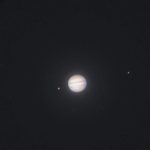Key Takeaways:
- A triple-star solar system, GW Orionis, offers a unique cosmic spectacle in Orion’s vicinity, potentially hosting the universe’s first known planet orbiting three suns.
- Recent studies suggest a hidden young planet or its early formation within the rings of dust surrounding GW Ori, causing gravitational anomalies.
- The presence of this potential planet could explain the system’s inner ring’s erratic movement, a phenomenon that defies conventional celestial mechanics.
- Most solar systems feature binary pairs, making GW Ori’s triple-star configuration exceptionally rare, with intricate gravitational dynamics.
- The system’s misaligned rings hint at a groundbreaking ‘disk-tearing effect’, possibly induced by an unseen planet at the verge of the inner and outer rings.
Situated on the cosmic tip of Orion’s nose lies a celestial marvel rivaling Tatooine, the famed twin-sunned world of Luke Skywalker. Named GW Orionis (GW Ori), this system resides some 1,300 light-years away and is an extraordinary exemplar of a triple-star solar system. At its core, two suns pirouette around each other, while a third star encircles its companions from hundreds of millions of miles away.
Previously identified by its three luminous rings of planet-forming dust, nestled like an immense orange target in the sky, a closer examination now suggests that these rings might encase more than mere particles. According to recent studies published in Science and The Astrophysical Journal Letters, there’s a likelihood of a nascent planet or its formative stages within these rings, potentially disrupting the system’s gravitational equilibrium. If confirmed, this enigmatic entity would mark the universe’s inaugural instance of a single planet orbiting three suns simultaneously.
Nienke van der Marel, an astrophysicist at the University of Victoria, Canada, and co-author of the May 21 study, asserts, “Our simulations show that the gravitational pull from the triple stars alone cannot explain the observed large misalignment [in the rings]. We think that the presence of a planet … has likely carved a dust gap and broken the disk [where the inner and outer rings meet].”

Triple-star systems like GW Orionis are exceptionally rare in the universe. Their existence hinges on a delicate gravitational dance; if the third star’s mass and distance from the pair aren’t precisely calibrated, it could be expelled from the system into interstellar space, as per a 1994 study in the Monthly Notices of the Royal Astronomical Society.
Even when three stars harmonize, their combined gravitational force manifests peculiar effects. Unlike our solar system, where planets orbit within a single disk aligned with the sun, GW Ori features three distinct dust rings orbiting its center, each out of alignment with the stars’ orbits. Intriguingly, the innermost ring juts diagonally, deviating dramatically from the plane.
Observations from the Atacama Large Millimeter Array (ALMA) telescope in Chile unveiled this misalignment, also revealing that the outermost ring, located 338 astronomical units from the system’s center, possesses enough dust mass to assemble 245 Earth-like planets, rendering it the most expansive protoplanetary disk in any known solar system.

In a concurrent Science study, a team of astronomers examined Ori’s eccentric rings using ALMA and the European Southern Observatory’s Very Large Telescope (VLT). These observations divulged the inner ring’s shadow against the outer rings, enabling precise measurements of its shape and size. The team also meticulously charted the orbits of the system’s three stars over 11 years, encompassing a complete orbital cycle.
Both studies collectively illuminate how the erratic movements of GW Ori’s stars could have contorted the solar system’s dusty disk through the ‘disk-tearing effect’. This is the first instance where a misaligned disk has been definitively linked to this phenomenon. Nevertheless, the researchers caution that the gravitational pull of the stars alone doesn’t entirely account for the system’s peculiar behavior.
The puzzle’s absent piece might be an undiscovered planet poised at the cusp of the inner and outer rings, as posited by the researchers. Stefan Kraus, a professor of astrophysics at the University of Exeter, U.K., and lead author of the Science study, asserts, “The inner ring contains enough dust to build 30 Earths, which is sufficient for a planet to form in the ring.”
Unlike any known planet, this hypothetical world would concurrently orbit all three suns at the solar system’s core. This distinguishes it from other eccentric exoplanets like LTT 1445Ab, which orbits a single star within a triple-star system, situated 22 light-years from Earth. Although concrete evidence for this planet’s existence is currently lacking, its potential presence suggests that planets might emerge even in the most idiosyncratic, misshapen solar systems.
Regrettably, even if this hypothetical planet exists, there’ll be no Skywalkers gazing longingly at the three-sunned horizon. According to the team’s models, this world would need to reside approximately 46 astronomical units from its host stars, a significantly greater distance than Neptune’s orbit from our sun (30 astronomical units). It would be a hostile realm, subject to a gravitational tug-of-war unlike any witnessed by scientists. May the Force be with it.


